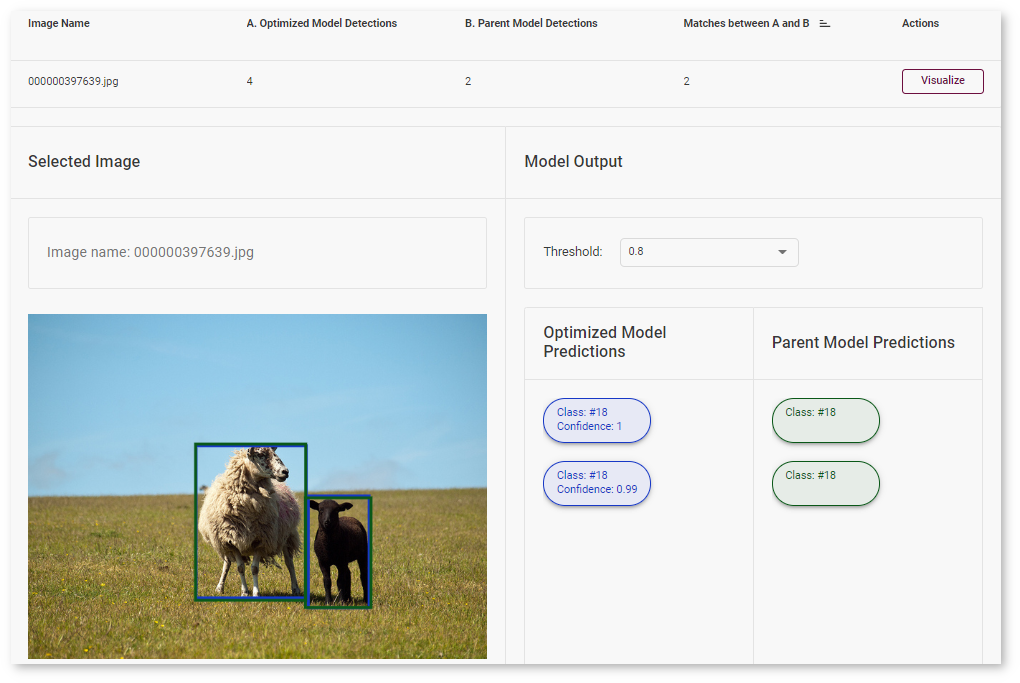Optimize Darknet* YOLOv4 Model¶
INT8 Calibration is a universal method for accelerating deep learning models. Calibration is a process of converting a Deep Learning model weights to a lower 8-bit precision such that it needs less computation.
In this tutorial, you will learn how to optimize your model using INT8 Calibration, evaluate the performance boost, and check the difference between original and optimized model accuracy.
Model |
Task Type |
Framework |
Source |
Dataset |
|---|---|---|---|---|
Use Darknet* YOLOv4 Tutorial to import the model in the DL Workbench. Refer to the Dataset Types page for more information about dataset import.
Optimize Model Using INT8 Calibration¶
To convert the model to INT8, go to Perform tab on the Project page and open Optimize subtab. Check INT8 and click Optimize.

It takes you to the Optimize INT8 page. Select the imported dataset and perform INT8 Calibration with Default optimization method and Performance Preset calibration scheme first as it provides maximum performance speedup.

After optimization, you will be redirected to a new Project page for optimized YOLOv4 model.

To ensure that the optimized model performance is sufficiently accelerated and its predictions can be trusted, evaluate the key characteristics: performance and accuracy.
Compare Optimized and Parent Model Performance¶
Go to the model page and check the performance of the imported and optimized models. Compare the throughput numbers and click Compare Projects. Learn more about projects comparison on the Compare Performance page.
Note
Throughput is the number of images processed in a given amount of time. It is measured in frames per second (FPS). Higher throughput value means better performance.

You can observe that YOLOv4 model has become 2.4x times faster on CPU device after optimization.
Lowering the precision of the model using quantization leads to a loss in prediction capability. Therefore you need to assess the model prediction capability to ensure that the model has not lost a significant amount of accuracy.
Compare Parent and Optimized Model Predictions¶
Create Accuracy Report¶
Go to the Perform tab and select Create Accuracy Report :

Comparison of Optimized and Parent Model Predictions Report allows you to find out on which validation dataset images the predictions of the model have become different after optimization. To enable the creation of this report type, change your model use case in the accuracy configuration. DL Workbench automatically detects Object Detection use case and other parameters for your model. Click Save :

You will be redirected back to the Create Accuracy Report page. Select Comparison of Optimized and Parent Model Predictions and click Create Accuracy Report :

Note
Accuracy measurements are performed on each dataset image. Creating an Accuracy Report may take some time if the dataset is considerably big.
Interpret Report Results¶
The report has two display options: Basic and Advanced mode.
Basic Mode¶
Each line of the report table in basic mode contains a number of detected objects in the image: A. Optimized Model Detections. The number of objects in Parent model predictions for the image is indicated in B. Parent Model Detections. If the numbers do not match, the model must be incorrect.
To assess the difference between Optimized and Parent model predictions, check Matches between A and B. Matches show the number of times the Optimized model detected the same location of an object as the Parent Model.

Advanced Mode¶
Each line of the report table in advanced mode contains a specific class that the model predicted for the object in the image - Class Predicted by Optimized Model. The number of detected objects of predicted class is represented in A. Optimized Model Detections of Predicted Class. The number of objects that have the same class in Parent model predictions is indicated in B. Parent Model Detections of Predicted Class. If the numbers do not match, the Optimized model might be incorrect.
To assess the difference between Optimized and Parent model predictions, check Matches between A and B and Predicted Class Precision. Matches show the number of times the Optimized model detected the same location of an object as the Parent Model.

TIP: To sort the numbers from lowest to highest, click on the parameter name in the table.
Click Visualize button under the Actions column to compare the predictions and annotations for a particular image.

In our case, the YOLOv4 model detected 2 objects of class 18 (sheep). These detections coincide with the dataset annotations: 2 objects of the same class as predicted by the model. The number of matches also equals 2. In the image, it is shown by almost identical bounding boxes for each object.

Let’s consider another example image. The model detected 1 objects of class 4 (airplane). But in the image, you can see that the bounding is noticeably different from the parent model prediction.
Next Step¶
After evaluating the accuracy, you can decide whether the difference between imported and optimized models predictions is critical or not:
If the tradeoff between accuracy and performance is too big, import an annotated dataset and use AccuracyAware optimization method, then repeat the steps from this tutorial.
If the tradeoff is acceptable, explore inference configurations to further enhance the performance. Then create a deployment package with your ready-to-deploy model.